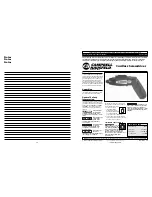
www.pulsar.pl HPSB2512B
GREEN POWER
6
Operating parameters
(tab.6)
Operating temperature
-10ºC...+40ºC (see: chart 1)
Storage temperature
-20ºC...+60ºC
Relative humidity
20%...90%, without condensation
Vibrations during operation
unacceptable
Impulse waves during operation
unacceptable
Direct insulation
unacceptable
Vibrations and impulse waves during transport
According to PN-83/T-42106
Chart 1. Acceptable output current from the PSU depending on ambient temperature.
2. Installation.
2.1 Requirements.
The buffer PSU shall be mounted by a qualified installer with appropriate permissions and qualifications for
230V/AC installations and low-voltage installations (required and necessary for a given country). The device shall
be mounted in confined spaces, according to the environment class II, with normal air humidity (RH=90% max.
without condensation) and the temperature from -10°C to +40°C. The PSU shall work in a vertical position that
guarantees sufficient convectional air-flow through ventilating holes of the enclosure.
Before installation, prepare a PSU load balance. During normal operation, the total current drawn
by the device may not exceed I = 2A
*
. Maximum battery charge current: 0,5A
*
. Total device current +
battery: 2,5A max
*
.
As the PSU is designed for a continuous operation and is not equipped with a power-switch, therefore an
appropriate overload protection shall be guaranteed in the power supply circuit. Moreover, the user shall be
informed about the method of unplugging (usually through assigning an appropriate fuse in the fuse-box). The
electrical system shall follow valid standards and regulations.
.
2.2 Installation procedure.
1. Before installation, cut off the voltage in the 230V power-supply circuit.
2. Mount the PSU in a selected location and connect the wires.
3. Connect the power cables (~230Vac) to L-N clips of the PSU. Connect the ground wire to the clip marked by the
earth symbol PE. Use a three-core cable (with a yellow and green PE protection wire) to make the connection.
Lead the cables to the appropriate clips through the insulating bushing of the connection board.
*
Refer to chart 1


























